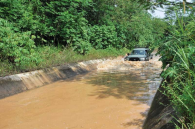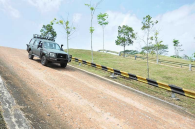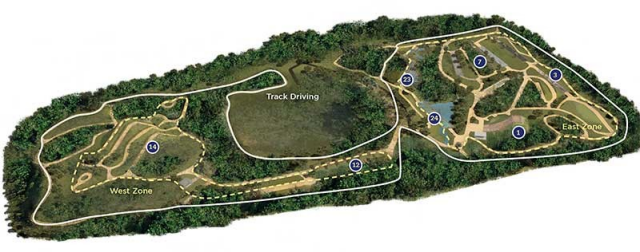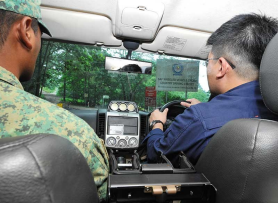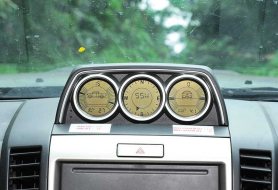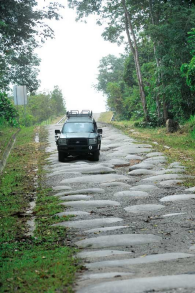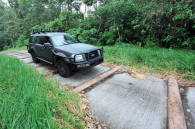OPS & TRAINING
NO ROAD, NO PROBLEM
19 Mar 2015

For some years now, Singapore Armed Forces (SAF) soldiers have learnt off-road driving skills in a purpose-built facility. PIONEER recently had a go at it.
In a small city-state criss-crossed with some of the best paved roads this corner of the globe, soldiers looking for some serious off-road driving training can find themselves in a bit of a fix. After all, crossing rough terrain is in every soldier's job description.
So what is an army to do? It builds a facility filled with the kind of obstacles and track conditions that a military driver might encounter, right in its own backyard.
"The SAF Cross Country Driving Circuit (CCDC) was built so that we can have the space to train capable transport operators in a realistic setting and to give them the confidence to deal with the cross-country road conditions that they have to negotiate during operations," said Chief Warrant Officer Devendran S K B, Commanding Officer SAF Supply and Transport Centre.
Completed in 2009, the CCDC is tucked away in the quiet Mandai area where many military camps sit. It is a 36-hectare facility built to train soldiers on the finer points of off-road driving.
The CCDC holds 26 stations ringed by a 5km track, and is filled with the kind of obstacles that seasoned rally race car drivers would be more accustomed to.
With inclines so steep that all you see is the sky to descents so hairy that they strain the braking foot, the CCDC is not a place to visit on a full stomach.
Rough roads
The stations are plainly named - Muddy Track, Plank Bridge and Trunk Logs - so that operators know exactly what they are getting themselves into.
Once on the course, trainees realise immediately what it is like to go off-road. And even the tiniest increase in speed seems to cause the vehicle to pitch and roll, making the stations more exciting than their monikers.
Trainees are also taught the right way of engaging different settings on the SAF vehicles, which allow them to negotiate roads that would faze less hardy vehicles. For example, the Ops Utility Vehicles (OUVs) have a "low-range" setting to give the vehicle more torque to climb steep inclines.
The SAF TTW was kind enough to let this journalist have a go at the CCDC, or so he thought, until he lost his appetite for lunch.
Delicate touch
Seasoned off-roaders like 2nd Warrant Officer (2WO) Loh Soon Hua, one of the instructors in the SAF Transport Training Wing (TTW), know that cross-country driving is not all about raw power. It is a matter of accelerating and braking at the right time and in the right amounts.
At the Camel Hump, the vehicle has to climb a series of small hills in quick succession. The driver needs to know when and how much to feather the throttle so that the climb does not transit into a hard landing on the descent.
On the descents, the brake has to be controlled precisely so that the vehicle rolls with just enough momentum to climb the next hump. It is a delicate balance between applying power and the brakes.
Done well, it feels like an up-and-down glide. Done badly, your last meal could well end up in your lap.
"Think of the instructors who go through this with the trainees. They (the trainees) do it once but we have to sit through multiple sessions," said 2WO Loh.
"That's why most instructors are especially quiet and stone-faced after a long day of cross-country driving!" he added with a wry laugh.
Giving confidence
All this training is not just about passenger comfort. Land hard into an obstacle and the vehicle (and its cargo) could be damaged - not something you want to happen when you need to be somewhere in a jiffy.
At the steep up-and-down slope station, that gentle throttle feathering (at the Camel Hump) is ditched in favour of some heavy acceleration. It is so steep that all the driver sees is the sky and the top of the vehicle bonnet during the ascent. "On such steep slopes, you need to give the vehicle the power it needs to climb," explained 2WO Loh.
On the subsequent (and equally steep) descent, trainees are taught to slow the vehicle to a crawl by applying the brakes hard. "(Go) too fast downhill and you could easily lose control," he noted.
The OUVs are fitted with an inclinometer (left) and yaw meter (right). In the centre is a directional compass. They also come with advanced off-road features such as four-wheel-drive and low-range gearing for extreme hill climbing.
Safety features
Although the CCDC is a rough-and-ready training track, there are many safety features built into it, said 2WO Loh. "We want to make sure that everyone gets realistic and safe training."
For example, the fording stations (where trainees practise driving through flooded roads) have drain holes built into the sides to maintain the right depth of water. SAF wheeled vehicles can typically ford waters about 60cm deep.
At the Plank Bridge, safety nets have been installed to "catch" trainees if they make a mistake and fall. This is especially important for trainees learning to manoeuvre the SAF reconnaissance motorcycles. Dropping into ditches is not a pleasant experience even with a helmet on.
At the step obstacle where motorcyclists train to ride up and down steps, the edges are rounded to minimise injury if the trainees fall. In addition, soldiers riding SAF motorcycles have to wear knee and elbow guards.
All trainees driving through the CCDC are first made to go through the steep 45-degree slope to learn the right actions when their vehicle cannot ascend the climb.
"It is a basic skill to be able to gently reverse your vehicle down the steep hill and that's why everyone has to go through this first station before being allowed into the CCDC," explained 2WO Loh.
Thorough quarterly inspections are also carried out to make sure that the CCDC is safe for use.
Wheelers (back)yard
It is this kind of training that gives SAF Transport Operators (TOs) the confidence to drive heavy-duty military vehicles.
"By going through training at the SAF CCDC, soldiers who need to operate SAF wheeled vehicles become more confident and ready for different kinds of situations," said 3rd Sergeant Muhammad Zamree, a Full-time National Serviceman and a junior instructor at the SAF TTW.
"It is the combination of going through all the different types of conditions to prepare the operators so that they know what to do," he added.
The CCDC is built for all types of SAF wheeled vehicles. This includes the motorcycles used by the recce troopers, the Light Strike Vehicles used by the Guardsmen, as well as the ubiquitous OUV and 5-ton trucks.
Stringent testing
To date, the CCDC has trained more than 85,000 soldiers. It is part of the stringent SAF-wide transport training system.
To drive SAF vehicles, soldiers are first trained on manual-gear (or stick-shift) vehicles before progressing to automatic-gearbox vehicles.
Before even heading onto the roads, trainees would have experienced driving in the simulators located at the SAF Kaki Bukit Driving Centre.
It is also no secret that the SAF holds its TOs to a higher standard on all levels when it comes to the training they receive.
On average, soldiers looking to obtain the SAF driving licence will have to go through more theory lessons than their civilian counterparts. They also go through about 2,100 minutes of practical driving, about three times more than the national average of 720 minutes.
When it comes to the actual test, the SAF soldier can only make mistakes earning less than 10 demerit points to pass, compared to 18 points for
the civilian equivalent test.
Think of that the next time you pass an SAF vehicle on the roads.
Off-roading!
It's easier when you've got the know-how (and this circuit).
Station 1
Steep Slopes
This is the first thing trainees have to tackle: how to safely reverse from an impassable steep slope when their vehicles can no longer climb.
Station 3
Rough Terrain
Feel the rock and roll as vehicles pass through this area filled with large smooth boulders. The trick? Even acceleration and careful avoidance of the larger stones!
Station 7
Trunk Logs
This station simulates overgrown roots in thick vegetation that can cause less skilful riders to tip and fall. Even in four-wheeled vehicles, this station requires the driver to have controlled acceleration to roll across smoothly.
Station 12
Camel Hump
Like its namesake, this is a series
of ups-and-downs to train riders
to ride over bumpy ground without losing balance. Also
helps them to get over the fear
of climbing steep slopes.
Station 14
Steep Up/Down Slopes
With a total distance of 100m,
this needs full power on the up
and controlled braking going down. This is a hairy one!
Station 23 & 24
Fording
These two stations train the correct techniques to drive across shallow waters with sandy bottoms (station 23) and rocky floors (station 24). They have a special drainage system to ensure that the water levels remain at a safe depth.
ALSO READ IN OPS & TRAINING
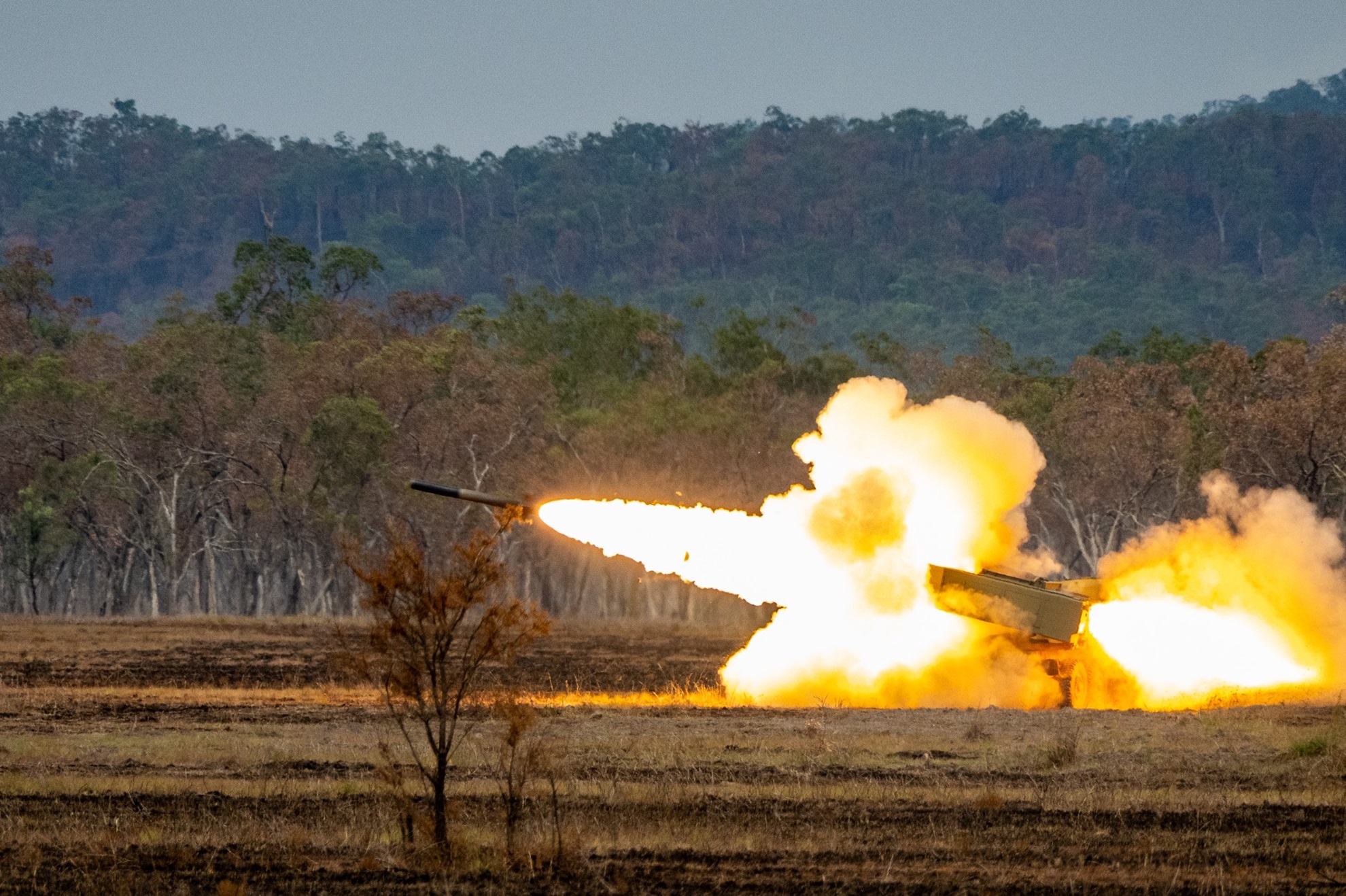
Exercise Wallaby 2025: To see better, shoot faster
31 Oct 2025
The SAF focuses on complex strike missions and multi-domain integration in Exercise Wallaby 2025, the 35th edition of its largest unilateral overseas exercise.
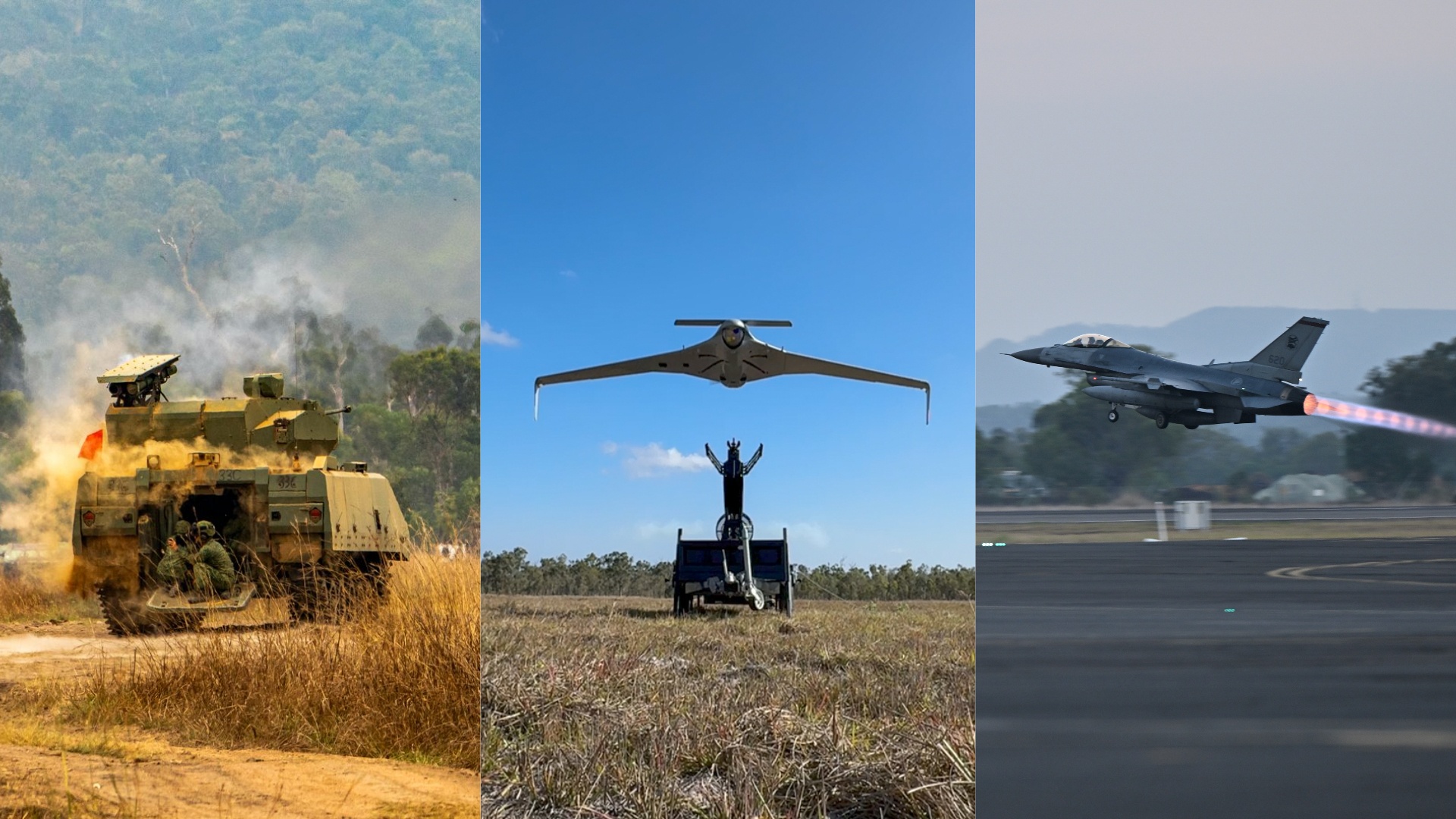
Ex Wallaby 25 – Greater Integration and Complexity
25 Oct 2025
The 35th edition of the SAF’s largest unilateral overseas exercise is an opportunity for expanded scale and deeper integration towards an effective, networked fighting force.

Ex Forging Sabre ramps up use of unmanned assets in integrated strike operations
12 Sep 2025
In this 10th edition of Exercise Forging Sabre, the SAF sharpened its cutting edge for the dynamic modern battlefield, with expanded integration between manned and unmanned platforms.


